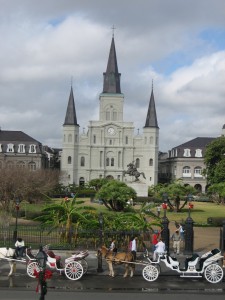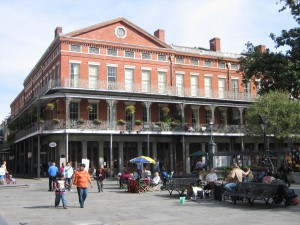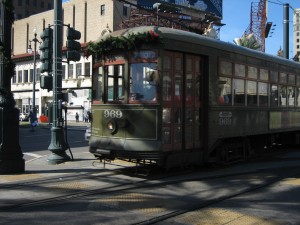Contributed by: Dahlia Adler Fisch | Last Date of Travel: December 2008

Kosher Info: New Orleans is a fantastic city for tourism; it’s fascinating, inexpensive, and has a culture unlike any other. However, walking the streets of the city as a Kosher Jew can be a challenge—New Orleans is a seriously food-centric city, and Cajun food is seriously treif. Fortunately, there is a Jewish community. Unfortunately, it’s primarily located in Metairie (MET-er-ee), a suburb of the city which cannot be reached on foot or by public transportation from the more popular destinations like the French Quarter. Metairie houses the eruv, the Orthodox Shul, and the only two kosher restaurants remaining in New Orleans after Hurricane Katrina. Cars or cabs are the only way to get to Metairie, and if you go the taxi route, be prepared to spend about $25 each way. If you do decide to travel to one of the restaurants, make it Casablanca, a delicious Moroccan restaurant with kitschy décor and a pleasant waitstaff. The other restaurant, Kosher Cajun, is certainly tasty, but less flashy and better suited for takeout than its competition. (For Shabbat meals, call Kosher Cajun by Thursday evening for Friday afternoon delivery—they’ll even take care of the grape juice and Challah.) Thankfully, both restaurants will gladly deliver to any hotel in the French Quarter for the fee of a one-way cab fare.
Since most tourists will be spending the majority of their time in the French Quarter, it’s best to be equipped

with some make-your-own-lunch staples. There are a number of Walgreens spread throughout the Quarter at which one can easily find things like peanut butter, tuna fish, and cereal; however, I strongly recommend that Kosher tourists bring their own bread, since it can be very difficult to find with a hashgacha. Truly though, the tastiest way to stave off hunger in the French Quarter is at Café Du Monde, a French Quarter landmark which sells only beignets (think Sufganiyot without the jelly), coffee, and hot chocolate, and which just became kosher in December 2008. No visit would be complete without at least one visit to this marvelous café, which is open 24/7 every day except Christmas.
Tourist Info: It’s no secret that New Orleans has gone through a lot of changes in the last few years since Hurricane Katrina. However, since the French Quarter emerged relatively unscathed, and the city has been hard at work repairing itself to its formerly glory, it’s almost impossible as a tourist to see any signs of the immense disaster unless you go looking for them. However, Katrina has had its effects in ways that are not blatantly obvious to non-natives, such as cutting the number of bus lines servicing the city in half. It’s very important that if you purchase a guide book for New Orleans, you make sure that it is no earlier than a 2009 edition, since earlier ones can easily contain important out-of-date information.
New Orleans has lots to see and most of it is blessedly inexpensive. The French Quarter provides endless entertainment both during the day, where you can busy yourself for hours looking at art on the streets, wandering into souvenir shops, walking along the Mississippi River, having your fortune told, and taking horse-and-carriage rides, and at night, when the streets are full of natives and tourists alike, singing karaoke, listening to jazz, sporting Mardi Gras beads, and drinking on the street. (The latter is mainly on the infamous Bourbon Street; for a slightly quieter view of the beautiful Quarter at night, try the tame but beautiful Dauphine Street, one block over.) Also located in the French Quarter is the Louisiana State Museum, which is actually a collection of buildings which mainly border the beautiful Jackson Square. Both the Cabildo, the historical museum in which the Louisiana Purchase was signed, and The Presbytere, which houses a fantastic and thorough exhibit on Mardi Gras, are worth their paltry six-dollar entrance fees. If museums are your thing, continue on to the New Orleans Museum of Art, which sits in the lovely City Park and includes a large sculpture garden. (The museum can be reached by riding the Canal Street Streetcar up to the last stop.)

Another New Orleans must-see is the Garden District, home to the wealthier New Orleanians an celebrities such as Archie Manning (father of Peyton and Eli) and John Goodman (who purchased his house from Nine Inch Nails frontman Trent Reznor). You can take a tour of this beautiful and historical area with a guide, or save yourself some money and follow the walking tour outlined by Frommers here. The Garden District can easily be reached by taking the St. Charles Avenue Streetcar.
Other popular tourist destinations and activities include the Audobon Zoo, Aquarium of the Americas (located by Riverside Mall and right near a bizarrely located Holocaust memorial), a steamboat cruise on the Mississippi, The National WWII Museum, going to the casino at Harrah’s, and art-gallery-hopping on Magazine Street. No matter what you choose to do, just be sure to bring your walking shoes—you’ll need ‘em.
A quick note about choosing which time of year to go: New Orleans tends to have volatile weather, but on the whole, you can expect winters to be fairly mild and pleasant, around 60 degrees. Since New Orleans is not a particularly popular destination for Christmas, hotels lower their rates around this time, and so I’d highly recommend planning your trip for the end of December, if possible. However, any time will do, except for summer, when the sweltering heat makes the southern city very unpleasant, and be wary of planning around Mardi Gras unless you’re actually looking to attend the event, since a reasonable hotel room may be nearly impossible to find.
Jewish Info: The Orthodox Jewish community of New Orleans is primarily located in Metairie, where the Orthodox Shul was forced to relocate after being damaged by Hurricane Katrina. However, there is a Chabad in the French Quarter with daily minyans as well as Shabbat services, and the website provides the names of two small hotels located within walking distance on St. Charles Avenue. The Chabad also contains a mikva, which is available by appointment only.


 Keeping Kosher in New Orleans, LA
Keeping Kosher in New Orleans, LA



New Orleans is home to the famous Touro Synagogue, which proudly says on its website is “the oldest outside of the original 13 colonies” and began its history in 1828.
http://www.tourosynagogue.com/aboutus/history/
The Tulane Hillel is also good for a visit – the school is nickanmed “Jewlane” for a reason.
This website serves a good purpose but I would like to remind its writers that being Jewish isn’t limited to orthodox traditions. There are tons of vibrant Jewish institutions around the world that contribute to Jewish culture and shouldn’t be excluded because they are not “on par” with a particular sect’s beliefs. Whether you prefer a mikva on Friday afternoons or a guitar on Saturday mornings, please keep in mind that there are different ways to travel Jewishly.
Hi Rachel,
Thanks for your post concerning the Touro Synagogue and Tulane.
Just as a minor correction, this blog isn’t about “traveling Jewishly” but rather it is about “traveling Kosher”. Thus, the authors of the various posts tend to be orthodox. Not all the authors are orthodox, but most are. In that respect, this blog is a resource for Kosher travelers, hence the name of the blog “Yeah Thats Kosher >> a Kosher Travel blog”. The Jewish information section to each post is an added bonus that we feel would be of interest to those reading this blog.
But, each writer is free to include what he or she feels is appropriate for his or her post.
I am fully aware of the various wonderful Jewish options that exist, and any writer who writes a post about kosher travel is free to include that information in their post.
This blog is not meant to be exclusive, but rather inclusive to all whom are interested in kosher travel.
Rachel, I thank you for your thoughts and comments, and I invite you to write a kosher travel post about another location not recently covered on the blog.
Take care.
~Dani
Thanks for this great post on New Orleans. I went to Tulane myself and it’s exciting to see people appreciating the city. Do you have any more info on Cafe du Monde being kosher? I know they only serve coffee and beignets but I’m just curious about the decision to become kosher and how it all happened. Got a link?
Sorry about that–I should have included a link in the article. A link to the teudah is actually now available on the website (which is linked to in the article), and though unfortunately I don’t know how to link in a reply, an article on the story about the cafe’s conversion to Kashrut is available at the following URL: http://blog.nola.com/brettanderson/2008/12/cafe_du_monde_celebrates_hanuk.html. Serious thanks are in order to Rabbi Topolsky!
When looking for an OU Orthodox synagogue actually with in walking distance of
downtown hotels you must go to Anshe Sfard Synagogue in the Garden District
of New Orleans. Located at 2230 Carondelet Street it is near the corner of
St.Charles Avenue and Jackson Avenue. Check them out at anshesfard.org
I am looking for a Jewish tour guide to take a group of 6 teens and 2 adults around “Jewish New Orleans.” If you know of anyone, or a tour guide yourself, please email me at spollack@aasynagogue.org Thanks!
There is a new Kosher Option in New Orleans! Kosher Caterer Andy Adelman
now works out of the Jewish Community Day School Kash-Root Cafe and
offers kids and adult lunches five days a week. You can contact him and
order your lunch the day before. Also, he makes homemade challah every
Friday. http://www.jcdsnola.org/#!kash-root-cafe/c1ksg